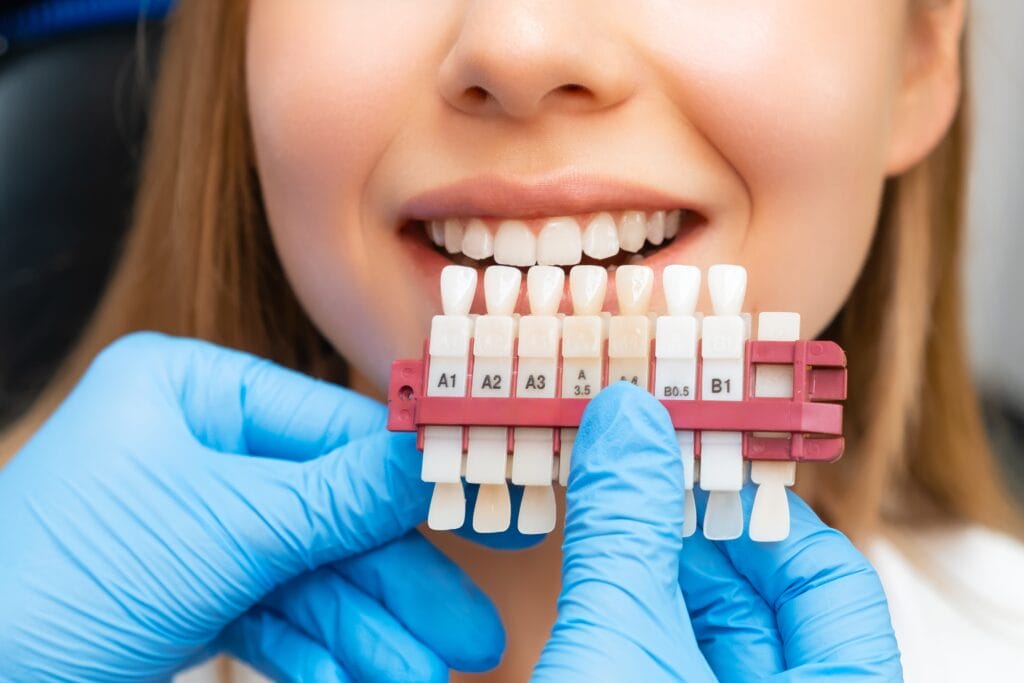Introduction
Teeth whitening has become increasingly popular as more people strive for a brighter, whiter smile. With numerous teeth whitening products and treatments available, it’s essential to separate fact from fiction. In this blog, we will debunk common myths surrounding teeth whitening and explore the reality behind these misconceptions, including the misconception that teeth whitening is only for achieving a “Hollywood” smile.
Unveiling the Truth Behind Teeth Whitening Myths
Teeth whitening has its fair share of myths and misconceptions. As always, there may be a kernel of truth to some of these myths, but there’s plenty of misinformation Let’s examine some of the most common myths and uncover the truth behind them.
Myth 1: Teeth Whitening Will Harm Your Enamel
One prevalent concern surrounding teeth whitening is that it damages the tooth enamel. The enamel is the outer protective layer of the tooth, and it is naturally white in color. The concern is that the bleaching agents used in whitening treatments, such as hydrogen peroxide, may harm the enamel.
There is no conclusive evidence that professional teeth whitening treatments pose any significant risks for your enamel, when done correctly. Improper use of some over-the-counter products, however, can cause side effects such as sensitivity and gum irritation. Follow instructions for safe results.
Myth 2: All Whitening Products Deliver the Same Results
In reality, professional whitening treatments are generally more effective than over-the-counter products. Professional treatments use stronger whitening agents and can be customized to meet individual needs. Dentists have the knowledge and expertise to apply the whitening agents properly and monitor the process to ensure optimal results.
On the other hand, over-the-counter whitening products may have lower concentrations of whitening agents and may not provide the same level of whitening. Additionally, without professional guidance, there is a higher risk of improper use, leading to unsatisfactory results or even damage to the teeth and gums.
Myth 3: Whitening Effects Are Permanent
While the whitening effects may last for several months to a few years, regular touch-ups or maintenance treatments may be necessary to maintain the desired level of whiteness. It is important to discuss with your dentist the best way to maintain your white smile and how often touch-ups may be needed based on your individual circumstances.
Myth 4: Baking Soda and Lemon Juice are Safe, Natural Whitening Methods
Baking soda is slightly abrasive, which can help remove surface stains from the teeth. However, excessive or frequent use can erode the enamel, the protective outer layer of the teeth. Similarly, lemon juice is acidic and can erode the enamel. While it may have some whitening properties, the acidic nature of lemon juice can damage the teeth and increase the risk of tooth sensitivity.
Myth 5: Whitening Toothpaste Can Replace Professional Whitening
Whitening toothpastes can help remove surface stains from the teeth and provide a slight brightening effect. However, they do not contain the same concentration of whitening agents as professional treatments, and they are not left on the teeth long enough to have a significant whitening effect.
Myth 6: You Cannot Whiten Your Teeth if You Have Crowns or Veneers
Crowns and veneers are made from materials that do not respond to whitening agents in the same way as natural teeth. If the color of implants, crowns, or veneers no longer matches the whitened natural teeth, they can be replaced with new restorations that better match the desired shade. Consulting with a cosmetic dentist is essential to ensure that the restorations blend seamlessly with the natural teeth for a harmonious smile.
Myth 7: UV Light is a Must for Effective Teeth Whitening
There is no solid scientific evidence to support this claim. UV light is sometimes used in teeth whitening procedures to enhance the whitening process. However, studies have shown that UV light may not significantly improve the results of teeth whitening and may have potential risks, such as oral tissue damage. Despite its portrayal in movies and TV, UV light is unnecessary for effective teeth whitening and may even be harmful.
Myth 8: Whitening is Suitable for Everyone
Factors such as oral health, tooth sensitivity, and the presence of dental restorations can affect the suitability of teeth whitening. Individuals with gum disease, tooth decay, or other oral health issues may need to address these conditions before undergoing whitening treatments. Whitening agents can cause irritation and increased tooth sensitivity, especially for individuals with pre-existing sensitivity.
A consultation with a qualified dentist is essential to determine if teeth whitening is appropriate for an individual’s specific oral health conditions and to discuss potential risks and benefits. Dentists can offer alternative solutions or recommend treatments to address specific concerns or conditions.
Myth 9: The Stronger the Chemical, the Better the Results
Whitening products typically contain either hydrogen peroxide or carbamide peroxide as the active whitening ingredient. Higher concentrations of these chemicals can lead to increased tooth sensitivity and gum irritation. The strength of the whitening agent should be determined based on individual needs and sensitivity levels. A dental professional can recommend the appropriate concentration and duration of treatment to achieve the desired results without compromising oral health or causing unnecessary discomfort.
Exploring Teeth Whitening Facts
Now that we have debunked the common myths surrounding teeth whitening, let’s explore the reality of this popular cosmetic dental procedure.
Fact 1: The Science Behind Teeth Whitening
Teeth whitening is a scientifically proven method of lightening the color of teeth and removing stains. The active ingredient in most teeth whitening products is hydrogen peroxide or carbamide peroxide. These chemicals penetrate the enamel and break down the molecules that cause tooth discoloration.
Numerous studies have shown the effectiveness of teeth whitening treatments in achieving desirable results. However, it is important to remember that individual results may vary based on factors such as the initial shade of the teeth, the extent of discoloration, and compliance with aftercare instructions.
Fact 2: Professional Whitening vs. Home Kits: What Option is Best?
Professional whitening treatments are performed by a qualified dentist and offer several advantages. The dentist can customize the treatment according to your teeth’s specific needs, ensuring optimal results. In-office treatments usually use a higher concentration of whitening agents, which can provide faster and more noticeable results. The dentist may also use techniques like heat or light to intensify the whitening process.
On the other hand, home whitening kits are more convenient and affordable. These kits typically include whitening strips or gels that you apply to your teeth yourself. While home kits can provide noticeable results, they may not be as effective as professional treatments. The concentration of whitening agents in these kits is lower, and the application process may not be as precise. However, it is important to consider the pros and cons of each type of whitening system before deciding which one works best for you.
Fact 3: How to Maintain Your Whitening Results for Longer
- Practice good oral hygiene: Brush your teeth at least twice daily and floss once daily. Using a whitening toothpaste may also help, though it is important to look at the ingredients.
- Avoid staining foods and beverages: Certain foods and drinks, such as coffee, tea, red wine, and dark-colored sauces, can stain your teeth. Limit your consumption of these items, or rinse your mouth with water after consuming them.
- Quit smoking: Smoking can yellow your teeth and cause various oral health problems. Quitting smoking not only improves your overall health but also helps maintain the whiteness of your teeth.
- Schedule regular dental cleanings: Professional cleanings from your dentist can remove surface stains and maintain the brightness of your teeth.
- Touch-up treatments: Your dentist may recommend periodic touch-up treatments to ensure long-lasting results. Follow your dentist’s recommendations.
By following these tips, you can enjoy the benefits of your whitening treatment for longer and keep your smile looking bright and beautiful.
Fact 4: Understanding the Role of Diet in Teeth Discoloration
Some foods and beverages can stain your teeth, leading to a dull or yellow appearance. Understanding the impact of your diet on tooth discoloration can help you make better choices for a whiter smile.
Coffee, tea, red wine, and dark-colored sodas contain chromogens, which are pigment-producing substances that can adhere to the enamel of your teeth. Over time, the repeated exposure to these substances can lead to staining. Acidic foods like citrus fruits and vinegar-based dressings can erode the enamel of your teeth, making staining more likely. If you consume acidic foods, wait at least 30 minutes before brushing your teeth to avoid further damage to the enamel.
Foods rich in antioxidants, such as apples, celery, and strawberries, promote oral health. Chewing sugar-free gum stimulates saliva production to wash away food particles and reduce staining.
Fact 5: Safety Measures and Precautions for Teeth Whitening
Teeth whitening is generally safe when done right, but it is important to take certain safety measures and precautions to ensure the best outcome. Here are some important considerations:
- Before undergoing any teeth whitening treatment, consult a qualified dentist. They will evaluate your oral health and determine if you are a suitable candidate for whitening. A dentist can also recommend the most suitable treatment option for your specific needs.
- Whether you are using a home whitening kit or undergoing professional whitening, it is necessary to follow the instructions provided by your dentist or the product manufacturer. Using whitening agents for longer than recommended or at higher concentrations can lead to tooth sensitivity, gum irritation, and other complications.
- Before undergoing teeth whitening, ensure that any existing dental issues, such as gum disease or cavities, are addressed. Whitening treatments can exacerbate these conditions and cause further damage.
- Choose teeth whitening products approved by reputable dental associations, such as the American Dental Association (ADA). These products have been tested for safety and efficacy.
- If you experience any undesirable changes in your teeth or oral health after teeth whitening, contact your dentist immediately. They can assess the situation and provide appropriate advice or treatment.
By following these safety measures and precautions, you can minimize the risks associated with teeth whitening and achieve a whiter smile safely.
Next Steps
Teeth whitening myths can lead to confusion and misinformation. Understanding the truth behind these myths is crucial for making informed decisions about your dental care. Professional guidance can help you separate fact from fiction and achieve the bright smile you desire. The best place to start is with a consultation. Get in touch with Creekside Family Dental by phone or online to set one up today.
 Meet Dr. Leffler
Meet Dr. Leffler
 Meet the Team
Meet the Team
 Dental Membership Plan
Dental Membership Plan
 Insurance Information
Insurance Information
 Patient Forms
Patient Forms
 Online Bill Pay
Online Bill Pay
 Your First Visit
Your First Visit





